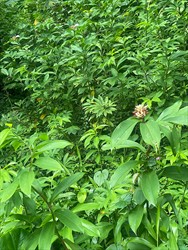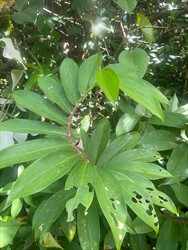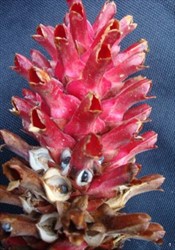- Widespread distribution. In Australia, and a majority of Pacific island countries. Environmental weed, tolerates shade, fast growing, forming thickets along roadsides, on waste ground, in disturbed and secondary forests, displacing native species in tropical and subtropics. Considered "an ecosystem transformer".
- Stem, erct or spreading, to 3 m, woody at base, spirally twisting with age. Leaves, alternate, shiny, hairy below. Flowers, terminal, with three white fused petals forming a tube around large trumpet-shaped structure (labellum) with crinkling at opening. Fruits, red/green containing black, glossy seeds.
- Spread: seeds by birds, rodents, shoes, machinery; and rhizomes. Long distances, international trade for ornamental and medicinal purposes.
- Biosecurity: high risk. Valued for ornamental and medicinal uses. Readily available on Internet.
- Biocontrol: none.
- Cultural: hand-pulling; collect stem pieces and burn. Probably, repeated applications necessary.
- Chemical: In FSM, triclopyr. Leaf spray and cut stump/paint treatments (see Fact Sheet no. 546).










